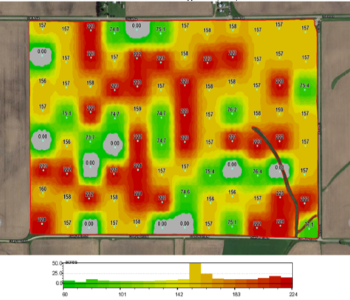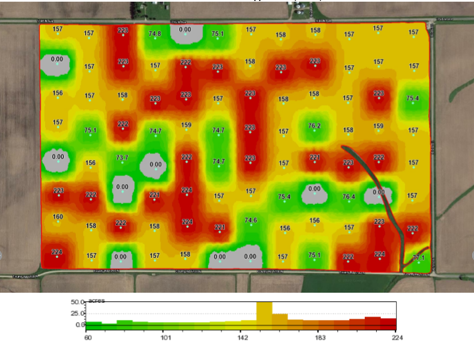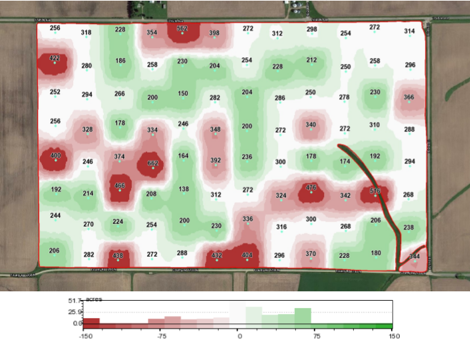Grid Sampling
Jul 10, 2020

Grid Samples
Grid sampling enables a producer to place fertilizer where needed rather than uniformly across the entire field. Through accurate fertilizer placement, you increase the odds of seeing a yield response to applied fertilizer. Additionally, all fields have a great amount of variability in fertility. This variability is the difference between being nutrient rich and nutrient poor in different portions of the field. There are many factors that could be affecting these nutrient levels such as field elevation, soil type, and previous management practices. Grid sampling will allow us to identify these areas and treat them appropriately.
(below)- Grid sample showing the variability in the field

(below)- Showing the over excess and under applied areas on a flat rate application

(below) showing the differences in an application of Flat rate vs Variable rate made from grid samples

PH levels and liming
Along with your grid samples comes PH levels in your fields, in our area PH levels are around 5.0-6.0 PH. Soil pH is an indicator of soil acidity. A pH of 7.0 is considered neutral. Values below 7.0 are acidic and values above 7.0 are basic. Small changes in numbers indicate large changes in soil acidity. Soil with a pH of 5 is 10 times more acidic than soil with a pH of 6 and 100 times more acidic than soil with a pH of 7. Most plants grow in slightly acidic soils thus, the goal of liming is not to raise the pH to neutral (7.0) but to avoid problems related to excessive acidity. Each crop reacts to soil acidity different.
Proper liming provides numerous benefits:
Grid sampling enables a producer to place fertilizer where needed rather than uniformly across the entire field. Through accurate fertilizer placement, you increase the odds of seeing a yield response to applied fertilizer. Additionally, all fields have a great amount of variability in fertility. This variability is the difference between being nutrient rich and nutrient poor in different portions of the field. There are many factors that could be affecting these nutrient levels such as field elevation, soil type, and previous management practices. Grid sampling will allow us to identify these areas and treat them appropriately.
(below)- Grid sample showing the variability in the field

(below)- Showing the over excess and under applied areas on a flat rate application

(below) showing the differences in an application of Flat rate vs Variable rate made from grid samples

PH levels and liming
Along with your grid samples comes PH levels in your fields, in our area PH levels are around 5.0-6.0 PH. Soil pH is an indicator of soil acidity. A pH of 7.0 is considered neutral. Values below 7.0 are acidic and values above 7.0 are basic. Small changes in numbers indicate large changes in soil acidity. Soil with a pH of 5 is 10 times more acidic than soil with a pH of 6 and 100 times more acidic than soil with a pH of 7. Most plants grow in slightly acidic soils thus, the goal of liming is not to raise the pH to neutral (7.0) but to avoid problems related to excessive acidity. Each crop reacts to soil acidity different.
Proper liming provides numerous benefits:
- Plants develop healthier roots because they are exposed to less potentially toxic aluminum. Better root growth may enhance drought tolerance.
- Lime is a source of calcium
- Nutrient solubility is improved by a higher pH therefore, plants have a better nutrient supply.
- Increased soil CEC occurs along with reduced leaching of basic cations, particularly potassium.
- Optimal pH allows the breakdown of some herbicides preventing damage to rotational crops.